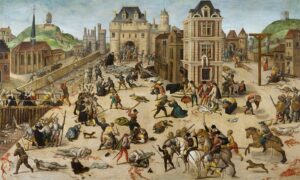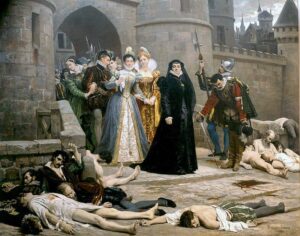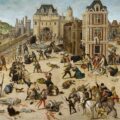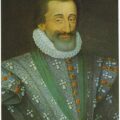
On this day in history, the 24th August 1572, an estimated 3,000 French Protestants (Huguenots) were massacred in Paris and a further estimated 7,000 in the provinces. According to tradition, Catherine de’ Medici persuaded her son, King Charles IX of France, to order the assassination of key Huguenot leaders who had gathered in Paris for the wedding of their leader, Henry of Navarre, to Margaret of Valois, the King’s sister.
The wedding had taken place six days earlier, on the 18th August, but the Huguenots were still in the city to discuss grievances regarding the 1570 Peace of Saint-Germain-en-Laye, the peace treaty which had ended the third French War of Religion. On the 22nd August, Admiral Gaspard de Coligny, the leader of the Huguenots, was shot and seriously wounded. It is not known who ordered the attempt on his life but there are three main suspects: the Guises (leaders of the Catholic party), the Duke of Alba (the man governing the Netherlands) and Catherine de’ Medici. Whatever the truth behind the assassination attempt, the shooting triggered trouble. The Huguenots were angry and demanded an investigation into the shooting, which the King agreed to do, but on the 23rd August the King and his mother agreed that the Huguenots were a threat that needed dealing with and made the decision to order the murders of the Huguenot leaders.
Just before dawn on the 24th August 1572, Admiral Coligny was stabbed to death by Besme, one of the Duke of Guise’s men, and thrown out of his bedroom window. This killing sparked off city-wide violence with Parisians turning on Huguenot men, women and children, killing them and throwing their bodies into the River Seine. The violence in Paris lasted three days but news of the Paris trouble sparked off massacres in Toulouse, Bordeaux, Lyon, Bourges, Rouen, Orléans, Meaux, Angers, La Charité, Saumur, Gaillac and Troyes, and the violence lasted until well into October in some cases.

We do not know exactly how many people died in these horrific massacres. The Huguenot Maximilien de Béthune, duc de Sully, who escaped the massacre in Paris by carrying a Book of Hours under his arm, reported that 70,000 Huguenots were murdered, whereas modern historians, Ranke and Henri Martin, estimate the number of victims in Paris at 2000. Philip Benedict, in his article The Saint Bartholomew’s Massacres in the Provinces, puts the death toll at 2,000 in Paris and 3,000 in the provinces, compared to a total of 30,000 quoted by historians F. Fernández-Armesto and D. Wilson in Reformation: Christianity and the World 1500 – 2000. Whatever the true figure, it was an horrific event and we should remember those who died.
Link to Elizabeth I: Between 1570 and 1573 Sir Francis Walsingham was the English ambassador to France and Elizabeth I relied upon him to help the Huguenots to negotiate with Charles IX in 1570. Walsingham was in Paris at the time of the St Bartholomew’s Day massacre and his home was actually used as a sanctuary by Protestants, including Philip Sidney. Walsingham was lucky to escape with his life.
Notes, Sources and Further Reading
- Wikipedia page on the St Bartholomew’s Day Massacre
- The Massacre of St. Bartholomew’s Day, Aug. 24, 1572 – An eye-witness report by De Thou (1553-1617)
- Saint Bartholomew’s Day – page from New Advent Catholic Encyclopoedia
- The Saint Bartholomew’s Massacres in the Provinces, Philip Benedict, The Historical Journal, Vol. 21, No. 2 (Jun., 1978), pp. 205-225, Cambridge University Press, cited in Wikipedia
- Reformation: Christianity and the World 1500 – 2000, F. Fernández-Armesto and D. Wilson, pp. 236-37, cited in Wikipedia




What about that commandment about not killing? I think Elizabeth said that there was only one God and the rest was dogma. She was definitely ahead of her time (she may still be ahead of our time!)
But what happened NEXT? Was a roll made of the dead? The wedding guests with Henry, how many were killed? What happened back in Navarre because of those murders?
What happened to the property of the dead? Was it entirely stolen by the murderers or was some reclaimed? By what process was it reclaimed? At what point could a victim’s heirs begin to clean up the looted shop or house and begin to live again? How was this resolved legally? How long did it take?
What did these murders do to the commercial life of Paris?
Hi aquart,
I studied the French Wars of Religion about 20 years ago but I can’t remember the full details of what happened and so am unable to answer your questions as it is not my area of expertise. I know there are various eye witness accounts of what happened – http://www.reformation.org/bart.html and in John Foxe’s Book of Martyrs, which does give numbers for those killed in various towns – see http://www.gutenberg.org/files/22400/22400-h/22400-h.htm#Page_57. I hope that helps.
The horror and sorrow must hang heavy in the heart of all who witnessed this atrocity, as well as the families of the slain. May the dead find peace with God, the families find comfort in scripture and the murders repent of their evil deeds.
Do I ever agree with lisaannejane. We never seem to learn. There is a whole lot a killing in the name of God! He must just shake his head at us, asking don’t they learn? I’ve told them and told them not to do this!!!!!!!!!!!!!!!!!!!!!!!!!! They don’t LISTEN!
Great job! I was so glad to find a blog post about the St. Bartholomew’s. I’ve made it my goal (or perhaps my “calling”) in life to mourn, honor, remember, and cherish the victims of the massacre, mostly by giving them names and identities when possible. Thanks for bringing this horrendous event to life and remembering the dead!